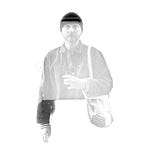In Praise Of Pictures Of The Horse And Cow Variety.
If pushed to call it I’d probably say that the western was my favourite genre. I’m not ordinarily one for looking at cinema in those terms, with genre, like particular actors a niche concern of mine when it comes to selecting the movies I would like to explore.
But yes, the western, or as my significant other would have it, “Horse and cow movies” is probably my favourite genre. While a genuinely great western is something of a major event in the contemporary cinema, I’m still frequently discovering previously unseen classics of the Golden Age of Hollywood with some regularity. Just this past few days I’ve seen two new-to-me-but-no-doubt-old-hat-to-others that I would like to briefly report back on here.
William Wellman’s The Ox-Bow Incident is carried by a title that sounds like it ought belong to some post-Watergate conspiracy thriller. It’s perhaps appropriate then that Wellman’s film remains socially politically relevant to the now of 2016, with it’s treatise on mob culture and post-fact groupthink one that strikes a considerable nerve with the world in which we now look at the movie. Anchored by a performance from Henry Fonda, whose player is but otherwise an observer to the chaos that surrounds him, Wellman’s film is one rendered in that most glorious pattern of monochromatic cinematographic light that seems so integral to this era of the movies. The film’s cinematographer Arthur Miller lensed such formidable pictures as A Letter To Three Wives and How Green Was My Valley, for which he won the Academy Award, and his work here is certainly of that calibre. One sequence, in which the three men who stand accused at the centre of the movie are placed bound and in front of the camera is as haunting an image as one is likely to ever see.
The biblical overarches of The Ox-Bow Incident’s main themes are echoed in the second western I watched of late, Delmer Daves’ Jubal. A borderline slight affair, Jubal sees Glenn Ford’s eponymous figure wind up working as a ranch hand for a kindly man played by Ernest Borgnine. Soap opera surrounds the pair, with Borgnine’s wife seeking comfort in the arms of the various men that help on the ranch, who are they themselves suspicious of the path that led Jubal to being in their company. While slight in plot the film’s heavy on the thematic side of things, with terms like “Shakespearean” and, yes, “biblical” feeling apt.
As with The Ox-Bow Incident it is in its aesthetics where Jubal shines brightest. The film’s shot-on-location environments are so idyllic that one might be forgiven for assuming they’re painted in; those blue skies look that otherworldly and beautiful. Quentin Tarantino would turn to the beautiful visage of Jackson Hole, Wyoming, when shooting Django Unchained, while Kevin Costner’s Dances With Wolves was also produced there.
Time has not been kind to Daves’, a mainstay of the western genre. This is in keeping with his status at the time he was working, with Bosley Crowther, who in a memorably glib review of Jubal written entirely in verse, criticised the film for being a dull retread of an earlier psychologically-driven western, calling it “a plain, warmed-over Shane”, while in the mid-1960s Andrew Sarris ended his brief entry on Daves in The American Cinema with the retort “the director does not so much transcend his material as mingle with it”. Even a gritty modern remake of 3:10 To Yuma, Daves’ best-known feature, has done little to bring him back in to focus, nor has his status as being one of only three men (alongside Howard Hawks and John Huston) to direct both Bogart and Bacall together on-screen in the excellent Dark Passage, a picture which pre-empted aesthetically much of the modern cinema.
